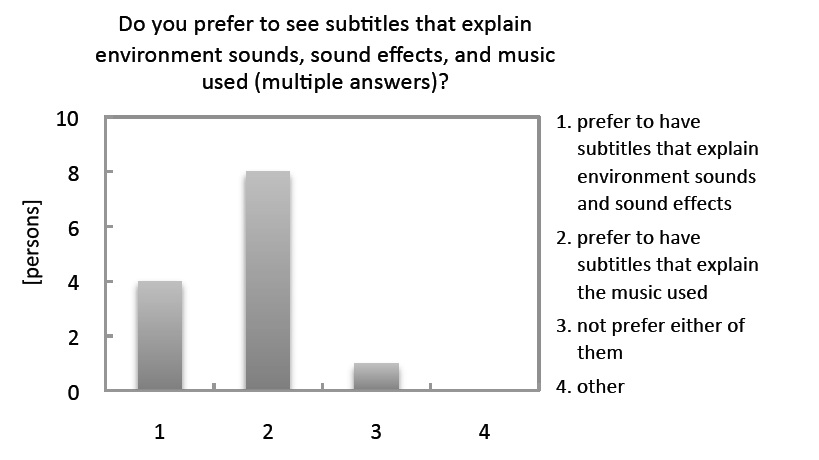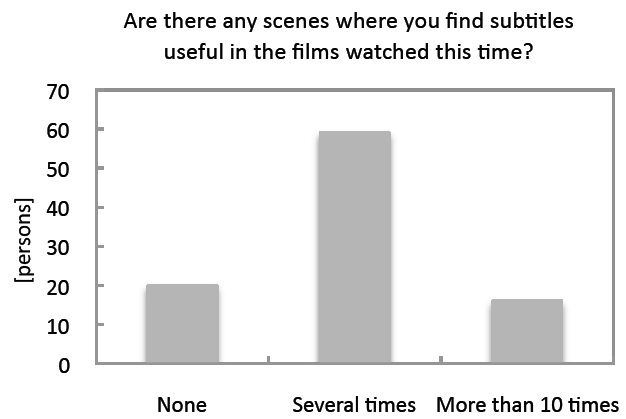1 Introduction
The presences of cinema and television are indispensable in enriching our daily lives and in supplementing cultural activities. However, with the super aging society in Japan accelerating and the number of people with various physical characteristics (such as hearing or visual impairment) on the increase, there still lacks a substantial system that allows these people to enjoy these contents that serves as one of the ways of enriching their daily lives. Until now, film directors and producers, subtitle creators, audio descriptors, people with disabilities, welfare participants, and the authours have come together to discuss research and issues regarding concerning how cinemas should be presented so anyone can enjoy them with or without disabilities. In the process of that, it became clear that subtitling for hearing-impaired people is insufficient in that, domestic films usually do not come with subtitle data as in the case of foreign films in Japan and when it comes to animations even lip-reading becomes useless, resulting thus in the still high barrier that prevents hearing-impaired people from enjoying cinemas.
With an aim to reexamine cinema subtitling for hearing-impaired people in Japan used until now, a questionnaire survey was conducted under this study at a film festival showcasing subtitles created by film producers, with people both with and without hearing disabilities as survey subjects.
2 Methodology
Prior to the survey, hearing-impaired people, film directors and producers, and subtitle creators were interviewed about their views on the creation of subtitles for Japanese films. From the interviews we were able to confirm the following 5 elements pertaining to the overall picture of cinema subtitling for hearing-impaired people:
-
the amount of subtitles in one scene or throughout the entire film;
-
the method of indicating who is speaking the subtitled script;
-
subtitles that explain the voice tone and accent of the spoken script;
-
subtitles that explain environmental sounds or sound effects;
-
subtitles that explain the music being played.
Based on the above 5 elements the questionnaire was then created. There were 11 Japanese and South Korean films shown at the festival (5 film drams, 1 anime, and 5 documentaries), and the questionnaire was answered by 17 hearing-impaired people and 170 hearing people.
3 Results and Examination
As an example of the survey results, Figure 1 shows the answers given by hearing-impaired people in response to the question “Do you prefer to see subtitles that explain environment sounds, sound effects, and music used (multiple answers)?” While comments like “There is no need to explain the music as I can’t hear it” were often given during past surveys, results of the survey conducted this time showed that a certain number of hearing-impaired people prefer to have subtitles that explain the music used. From this and from the results obtained for the question “What kind of information concerning music would you like to have subtitled?” it was revealed that most respondents requested for the subtitling of song lyrics. On the other hand, the results obtained from the responses by hearing people show that almost half of people (64 out of 137 (48 %)) respondents answering “Sometimes” or “Often” to the question “Do you ever find voices in films in daily life hard to catch?” Furthermore, responses given by the highest number of people concerning such specific aspects were “It’s hard to hear what is being said because the background music is too loud”, or answers to the “Other” section like “The actors’ voices are not loud enough” and “The people speaking don’t speak clearly”. Furthermore, as shown in Figure 2, in response to the question “Are there any scenes where you find subtitles useful in the films watched this time?” 75 out of 95 (79 %) people who provided valid answers said either “Several times” or “More than 10 times”.
4 Summary
Under this current study an in-depth questionnaire survey was conducted on the content of subtitling with direct involvement by film directors and producers in subtitle creation. The results of the survey allowed us to grasp some of the specific elements required in subtitling or the needs of hearing-impaired people when it comes to the text representation of environment sounds, sound effects, or music that have hitherto been insufficiently described in Japanese films. Meanwhile, the survey results also suggest the possible advantages of subtitling, such as in helping not only deaf or hearing-impaired people and people suffering from medium or severe haring disabilities who hold a disability certificate, but also young to senior people who are beginning to experience deterioration in their hearing understand information that is hard to catch by ear (such as the spoken script). From these, the following possibilities and issues of subtitling as a universal method in Japan’s progressing super-aging society were obtained.

[Fig. 1] Results obtained from the responses by hearing-impaired people.

[Fig. 2] Results obtained from the responses by hearing people.











